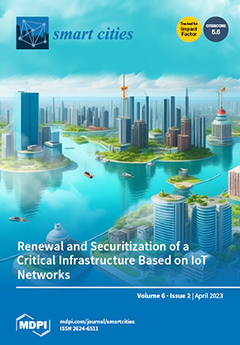With the level of development of the smart city, there are more and more research sub-areas in which the latest material and technological solutions are used, enabling the proper management and functioning of these cities. On the one hand, the introduced materials and
[...] Read more.
With the level of development of the smart city, there are more and more research sub-areas in which the latest material and technological solutions are used, enabling the proper management and functioning of these cities. On the one hand, the introduced materials and technologies are designed to facilitate the functioning of residents both in the urban space and at home; on the other hand, the implemented solutions strive to be consistent with the principles of sustainable development. As shown in this article, reports on new technical and technological solutions and their positive and negative effects are strongly emphasized in publications on the development of smart cities. The most highlighted materials research in the smart city area concerns smart materials and their characteristics and applications. A research gap in this area is in the presentation of material solutions, particularly materials intended for the load-bearing structures of vehicles (electric vehicles, flying vehicles) or infrastructure elements (buildings, shelters, etc.) designed to increase the durability of the structure while reducing its weight. This paper aims to comprehensively present the most important research areas related to the functioning of smart cities in light of previous research, with particular emphasis on new material solutions used for thin-walled load-bearing structures in smart cities made of AHSS (advanced high-strength steel). These solutions are very essential for smart cities because their use allows for the installation of additional devices, sensors, transmitters, antennas, etc., without increasing the total weight of the structure; they reduce the number of raw materials used for production (lighter and durable thin structures), ensure lower energy consumption (e.g., lighter vehicles), and also increase the passive safety of systems or increase their lifting capacity (e.g., the possibility of transporting more people using transports at the same time; the possibility of designing and arranging, e.g., green gardens on buildings; etc.). AHSS-welded joints are usually characterized by too-low strength in the base material or a tendency to crack. Thus, the research problem is producing a light and durable AHSS structure using welding processes. The research presented in this article concerns the possibility of producing welded joints using the Metal Active Gas (MAG) process. The test methods include the assessment of the quality of joints, such as through visual examination (VT); according to the requirements of PN-EN ISO 17638; magnetic particle testing (MT); according to PN-EN ISO 17638; and the assessment of the selected mechanical properties, such as tensile strength tests, bending tests, and fatigue strength checks. These methods enable the selection of the correct joints, without welding defects. The results have a practical implication; advanced production technology for obtaining AHSS joints can be used in the construction of the load-bearing elements of mobile vehicles or parts of point infrastructure (shelters, bus stops). The obtained joint is characterized by adequate strength for the production of the assumed structures. The originality of the manuscript is the presentation of a new, cheaper, and uncomplicated solution for obtaining an AHSS joint with good mechanical properties. The application of the presented solution also contributes to sustainable development (lower fuel and material consumption use by mobile vehicles) and may contribute to increasing the load capacity of mobile vehicles (the possibility of transporting more people).
Full article





